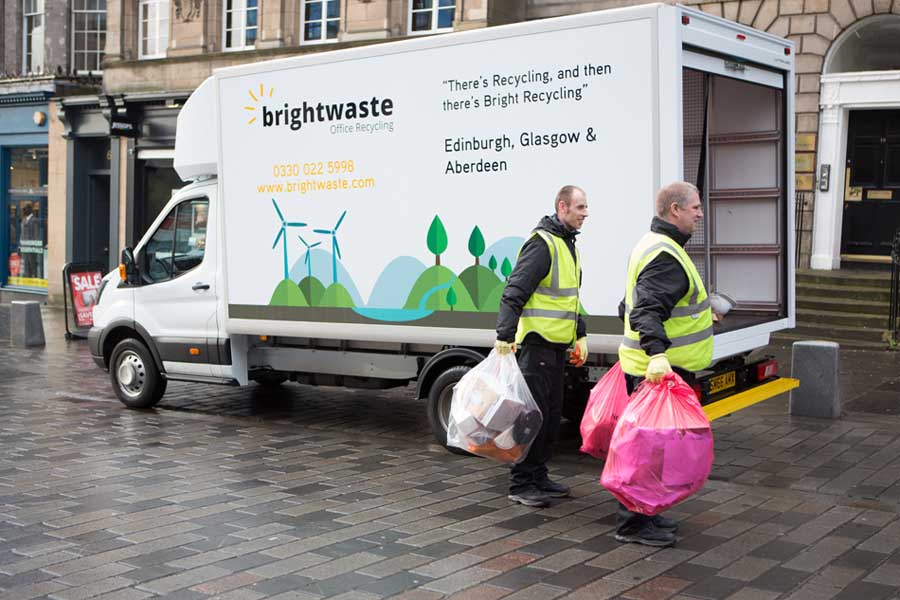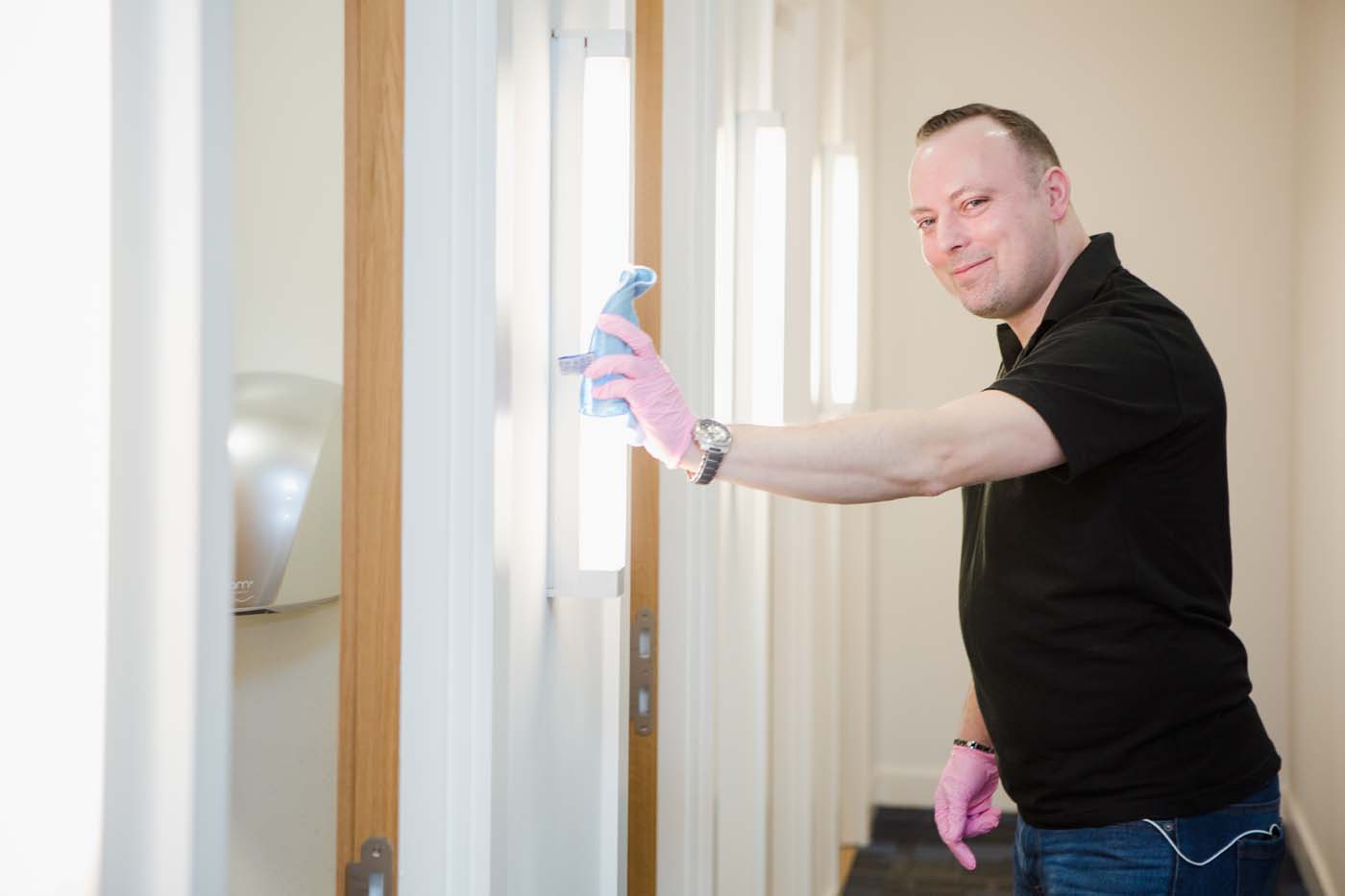 Let’s face it, office recycling can be a chore.
Let’s face it, office recycling can be a chore.
You have your meal deal lunch at your desk. You know you can recycle the plastic bottle, but you’re not really sure about the crisp packet and the half-cardboard half-perspex sandwich wrapper.
You need to get on with your work, so you just find the nearest bin, throw it all in and focus on more pressing matters.
But here’s the thing. BY LAW offices have to recycle. The Scottish government has set a 70% target for recycling, and the pressure at work is going to get greater and greater for easy, instinctive recycling systems.
And your commercial cleaning company should help and encourage you to do the right thing.
So, here’s the Ten Point Office Recycling Plan from Spotless for all businesses who want to do office recycling correctly.
1. Understand the benefits of recycling. Recycled waste costs about 25% less than general waste. Why? Because recycled waste does not have an inbuilt landfill levy. Instead, the waste can be sold as a commodity and this discounts the collection costs.
2. Set a recycling target. We recommend that you align with the government target of 7 bags of recycling waste for every 3 sacks of general waste.
3. Get great bins to help you. Spotless works with (actually owns) Brightwaste who can supply FREE bins and FREE recycling advice for your office. Sometimes this will be neat cardboard bins. Sometimes really smart, airport-style bins for segregated waste.
4. Do away with bins under desks. 20 years ago every office had desk bins. Now 60% of offices use central bins, often reducing their office cleaning costs. Place the recycling bins strategically around the office. Keep them in areas where most of the waste is generated such as photocopying, meeting and breakout rooms, as well as cafes.
5. Get free help. Ask your waste company to come in and talk to your staff. Brightwaste Office Recycling offer this service for free.
6. Launch and promote your recycling initiative to staff. Hold a launch event to share the value and objectives. It’s worth including helpful (and humorous) messages using posters and stickers with gentle reminders on the benefits and desired outcomes.
7. Motivate your staff by linking recycling with valued charitable causes. Electronic products like PCs, laptops and mobile phones, as well as ink cartridges, can be donated to charities. Redundant office furniture can also go to charities.
8. Discuss and agree the collection strategy with your waste company. Kerbside collection or car park collection? And if car park, what size of bine suits? Make sure you’re not being miss-sold a bin that is too big for your needs.
9. Obtain data from your waste company. Ask them for a carbon report to show comparatives on your recycling between any 2 dates.
10. Lastly, find ways to reduce your waste and recycling output before it hits the bins. A creative team review will allow you to find more ways to reduce waste so that you don’t have to bin it: print less and on both sides; reuse plastic containers; maintain and upgrade computers to extend their lives.
You may not know that methane is produced in landfill from biodegradable waste, and methane is 23 times as potent as a greenhouse gas compared to carbon dioxide.
You may not be aware that making new products from recycled materials requires much less energy than manufacturing from virgin materials. For example, recycling aluminium into new cans needs 95% less energy than processing the raw material, bauxite ore, into aluminium.
If you get the recycling basics right, it doesn’t need to be a chore. Instinctively you will learn what to recycle and what not to.
Eventually you’ll find that the cost savings are not the motivation. It’s not even the fact that you are legally compliant. It’s simply the fact that you know you are doing the right thing for the environment, and you are doing it well.
If you genuinely get your staff on board, you’ll turn recycling into a mission.
Ask Spotless Commercial Cleaning or its sister company, Brightwaste Office Recycling, for a free recycling review.
 After a few years in the commercial cleaning business I soon learnt that all cleaning companies say that they are ‘excellent’ at everything they do and they all promise their customers the world. Prospective customers are unsurprisingly distinctly immune and unimpressed by this hyperbole.
After a few years in the commercial cleaning business I soon learnt that all cleaning companies say that they are ‘excellent’ at everything they do and they all promise their customers the world. Prospective customers are unsurprisingly distinctly immune and unimpressed by this hyperbole.
I realised that it almost became a differentiator to not boast or make grandiose claims, but instead to take a more modest approach and rely on testimonials and case studies from commercial cleaning customers who were genuinely satisfied with the service they were receiving.
So our Spotless mantra purposefully became to quietly under-sell and over-deliver.
But a new feedback tool is now out there that has encouraged us to make more of our strong track record of great customer service and loyal customer base. The independent B2B review website.
Review sites, especially TripAdvisor and Yelp have revolutionised our decision making in the hospitality and B2C market, but the world of B2B reviews is still in its relative infancy. And where this does exist, it seems to be mostly associated with trades and small businesses.
Is ‘big’ business worried by what they might find out? Might they be embarrassed by hearing what people really think of the service their business provides?
Customer feedback via independent review sites is gradually becoming an opportunity for large UK wide B2B businesses to really differentiate themselves from their competitors.
Joining Feefo
So, after some research Spotless Commercial Cleaning has taken the plunge and joined Feefo, who provide trusted independent reviews.
It was a risk. We always ‘think’ we provide good customer service, but have we been deluding ourselves?
We measure our Quality Score in every contract. But real satisfaction in the cleaning industry is often subject to the invisible metrics of relationships and trust.
Would our customers be kind to us, or were we about to be sorely disappointed? Would anyone reply? Writing reviews can be time-consuming.
We sent out review requests to our customers and held our breath.
The initial buzz was exciting. Thirty reviews poured in immediately, and almost all awarded us 4 or 5 stars, plus a couple of 3s to make sure we didn’t get too pleased with ourselves.
After a few days we hit an average rating of 4.2, and after 90 reviews in our first month we’ve stayed at that rating.
I’ve personally replied to every review thanking the customer for their feedback, especially anything negative. We even retained one unhappy customer by addressing his concerns with a quick turnaround following his comments.
Most of our reviewers have given their names which is ideal but they can also be anonymous, perhaps encouraging more candid feedback. All comments are valuable and help us improve our service.
Our star ratings already appear on our organic search listings. The stats tell me that this alone gives a 17% rise in click through rates. Search engines love reviews.
Countless studies have shown that more reviews mean more revenue. One popular study by iPerceptions found that customers are 63% more likely to buy from websites that display customer reviews.
The possible downsides
So, what are the drawbacks? Last week we tendered for a £500k contract and made much of our Feefo rating as a differentiator. Then, we received a 3 star review and it sat at the top of our list for two days while we waited and hoped for some better reviews to replace it.
So, we re-sent the invitation to those customers who had not responded the first time asking them to review our business, and to our relief a torrent of fresh 4s and 5s came in.
It’s good to have some bad ratings
However, we have learnt that having some bad ratings makes the good ratings more believable. If all ratings are good then prospects are less likely to believe them.
Companies should acknowledge mistakes, correct inaccuracies, and, if necessary, take the conversation offline. The tone should be constructive and not defensive.
How good is good enough? For most people I’ve spoken to, anything over 4 out of 5 is a positive buying message. I think we’d all think twice about staying at a hotel where the rating starts with a 3.
Reviews make us raise the bar
And has it changed how we think? Yes! 4.2 out of 5 is the new benchmark at Spotless, and we want to do even better.
Now I look at 4.5s and over in any business sector with a touch of envy and it encourages me to try harder. How can we better improve our customers’ experience? What could we have done differently to get a higher score? What’s stopping every customer being delighted with the service they receive?
Suddenly customer service matters a whole lot more. And that’s progress.
See more on the Spotless Commercial Cleaning website.





